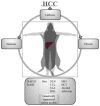Animal Models of Hepatocellular Carcinoma Prevention
- PMID: 31739536
- PMCID: PMC6895981
- DOI: 10.3390/cancers11111792
Animal Models of Hepatocellular Carcinoma Prevention
Abstract
Hepatocellular carcinoma (HCC) is a deadly disease and therapeutic efficacy in advanced HCC is limited. Since progression of chronic liver disease to HCC involves a long latency period of a few decades, a significant window of therapeutic opportunities exists for prevention of HCC and improve patient prognosis. Nonetheless, there has been no clinical advancement in instituting HCC chemopreventive strategies. Some of the major challenges are heterogenous genetic aberrations of HCC, significant modulation of tumor microenvironment and incomplete understanding of HCC tumorigenesis. To this end, animal models of HCC are valuable tools to evaluate biology of tumor initiation and progression with specific insight into molecular and genetic mechanisms involved. In this review, we describe various animal models of HCC that facilitate effective ways to study therapeutic prevention strategies that have translational potential to be evaluated in a clinical context.
Keywords: animal models; hepatocellular carcinoma; prevention.
Conflict of interest statement
The authors declare no conflict of interest.
Figures

References
-
- Global Burden of Disease Cancer Collaboration. Fitzmaurice C., Akinyemiju T.F., Al Lami F.H., Alam T., Alizadeh-Navaei R., Allen C., Alsharif U., Alvis-Guzman N., Amini E., et al. Global, Regional, and National Cancer Incidence, Mortality, Years of Life Lost, Years Lived With Disability, and Disability-Adjusted Life-Years for 29 Cancer Groups, 1990 to 2016: A Systematic Analysis for the Global Burden of Disease Study. JAMA Oncol. 2018;4:1553–1568. doi: 10.1001/jamaoncol.2018.2706. - DOI - PMC - PubMed
-
- Global Burden of Disease Liver Cancer Collaboration. Akinyemiju T., Abera S., Ahmed M., Alam N., Alemayohu M.A., Allen C., Al-Raddadi R., Alvis-Guzman N., Amoako Y., et al. The Burden of Primary Liver Cancer and Underlying Etiologies from 1990 to 2015 at the Global, Regional, and National Level: Results from the Global Burden of Disease Study 2015. JAMA Oncol. 2017;3:1683–1691. doi: 10.1001/jamaoncol.2017.3055. - DOI - PMC - PubMed
Publication types
Grants and funding
LinkOut - more resources
Full Text Sources

